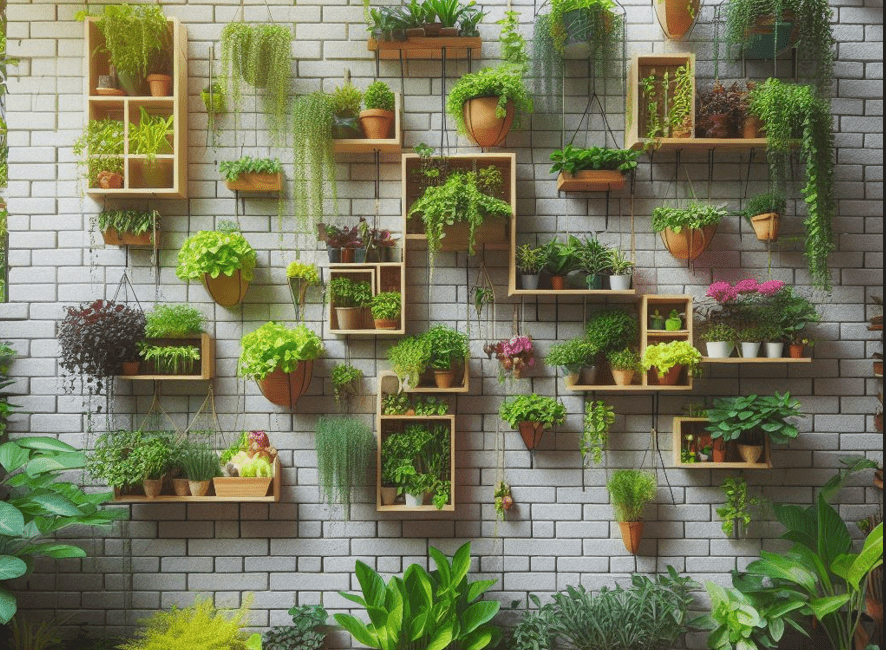In today’s urban landscapes and limited outdoor areas, space for traditional gardening may be at a premium. However, with vertical gardening, you can transform even the smallest of spaces into lush, green oases bursting with life and beauty. Vertical gardening offers a creative solution for maximizing your growing space while adding visual interest and charm to your walls, balconies, and patios. In this guide, we’ll explore the art of vertical gardening and share tips for creating stunning vertical gardens that elevate your outdoor spaces to new heights.
Unlocking Vertical Potential
Vertical gardening is a versatile technique that allows you to grow plants vertically, either on walls, fences, trellises, or specially designed structures. By utilizing vertical space, you can cultivate a wide variety of plants, including flowers, herbs, vegetables, and even small fruit trees, without the need for sprawling garden beds or expansive yards. Whether you’re a seasoned gardener looking to expand your growing space or a beginner eager to green up your living environment, vertical gardening offers endless possibilities for creativity and expression.
Choosing the Right Plants
When planning your vertical garden, it’s essential to choose plants that are well-suited to vertical growing conditions. Look for plants that have shallow root systems, compact growth habits, and the ability to thrive in containers or hanging baskets. Some excellent options for vertical gardens include:
- Vining Plants: Climbing vines such as ivy, jasmine, and climbing roses are ideal for covering trellises, fences, and walls with lush foliage and colorful blooms.
- Herbs and Vegetables: Compact herbs like basil, thyme, and parsley, as well as vegetables like cherry tomatoes, peppers, and lettuce, can thrive in vertical gardens, providing a fresh and flavorful harvest right at your fingertips.
- Succulents and Air Plants: Low-maintenance plants like succulents and air plants are well-suited to vertical gardening, as they require minimal soil and water and can be easily mounted on walls or displayed in vertical planters.
- Flowering Annuals: Annual flowers such as petunias, marigolds, and nasturtiums add vibrant color and texture to vertical gardens, creating a stunning visual display throughout the growing season.
Designing Your Vertical Garden
When designing your vertical garden, consider factors such as sunlight exposure, watering needs, and aesthetic preferences to create a cohesive and visually appealing display. Here are some design tips to help you get started:
- Choose the Right Location: Select a sunny or partially shaded location for your vertical garden, taking into account the light requirements of your chosen plants. South-facing walls typically receive the most sunlight, while north-facing walls may be better suited to shade-loving plants.
- Use Vertical Structures: Install trellises, arbors, or wall-mounted planters to support climbing plants and create a framework for your vertical garden. Consider incorporating vertical elements such as hanging baskets, tiered planters, or stacked containers to add depth and dimension to your design.
- Layer Plants Strategically: Arrange plants in your vertical garden according to their size, growth habits, and water requirements, placing taller plants at the back and smaller plants towards the front. Mix and match different plant varieties to create visual interest and contrast in your garden design.
- Consider Maintenance Needs: Factor in the maintenance requirements of your vertical garden, including watering, fertilizing, pruning, and pest control. Choose plants that are compatible in terms of care and maintenance to ensure a healthy and thriving garden.
Caring for Your Vertical Garden
Once your vertical garden is in place, it’s essential to provide proper care and maintenance to keep it looking its best. Here are some tips for caring for your vertical garden:
- Water Regularly: Monitor soil moisture levels and water your vertical garden as needed, taking care not to overwater or underwater. Consider installing drip irrigation or self-watering systems to ensure consistent moisture levels and reduce watering frequency.
- Fertilize Occasionally: Apply a balanced fertilizer to your vertical garden periodically to replenish nutrients and promote healthy growth. Follow the manufacturer’s instructions for dosage and application frequency based on the needs of your plants.
- Prune and Deadhead: Trim back overgrown foliage, remove spent blooms, and prune as needed to maintain the shape and appearance of your vertical garden. Regular pruning helps prevent overcrowding, improves air circulation, and encourages new growth.
- Monitor for Pests and Diseases: Keep an eye out for signs of pests or diseases in your vertical garden, such as yellowing leaves, wilting foliage, or unusual spots or discoloration. Address any issues promptly with organic pest control methods or appropriate treatments to prevent further damage.
Transforming Your Outdoor Space
Vertical gardening offers a creative and practical solution for maximizing your growing space while adding beauty and greenery to your outdoor environment. Whether you’re working with a small balcony, a compact patio, or a sprawling backyard, vertical gardens provide endless opportunities for expression, experimentation, and enjoyment. By harnessing the power of vertical space and embracing the art of gardening in three dimensions, you can transform your outdoor space into a vibrant and thriving oasis that delights the senses and nourishes the soul.


